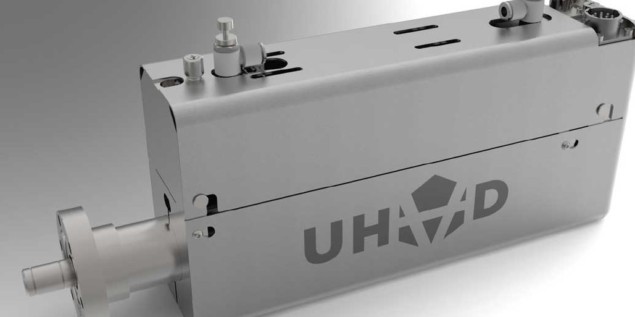Spring-loaded magnetically-coupled device provides a fail-safe solution that could reduce unscheduled downtime due to loss of ultrahigh vacuum

A customer enquiry for a linear power probe – a magnetically-coupled actuator that can operate remotely in vacuum – has led to a new fail-safe design that could improve the operability of beamlines around the world.
“CERN explained that they were looking for a product that would avoid using bellows,” says Jonty Eyres, engineering director at UHV Design. The UK-based firm specializes in the design, manufacture and supply of motion and heating products specified for use in high- and ultrahigh vacuum conditions.
“Bellows-sealed devices have been the go-to space for moving things in and out in a clean manner and with minimal outgassing,” Eyres explains. Depending on the type of bellows used, and their application, their service life can reportedly range from 10 000 up to as many as 2 million actuations. But they won’t last forever. And when they fail it can lead to an unexpected loss of vacuum and costly delays.
The challenge for Eyres and his colleagues was to come up with a solution that reproduced the clean operation of a bellows-sealed device, but in a fail-safe manner.
Magnets offer alternative
Over the past 20 years, the firm has developed considerable expertise in magnetically-coupled devices. Their bellows-free approach features an arrangement of magnets located inside and outside a rigid tubular vacuum envelope. Moving the magnetic housing on the outside advances and retracts an actuation shaft held centrally inside the device. The team used specialized software to optimize both the magnetic coupling between the inside and the outside, and the screening of the device.
Online meetings allowed the client – in this case CERN – to voice the product criteria that were important to them. “We used the sessions to discover their feedback, the pros and cons and where we think the scope is in terms of performance,” Eyres explains.
“Once we are confident in a prototype, the next stage is to put it on a vacuum rig and start running rigorous tests on performance and precision,” says Eyres. This includes carrying out residual gas analysis using a mass quadrupole device to examine how the mechanism affects the vacuum pressure.
A major benefit of the firm’s design is that there are no bellows to fail. But instead the team has to contend with moving parts in vacuum. The engineers tackled this by keeping the contact areas to a minimum and using rolling parts, not sliding parts, to limit any pressure rise during operation. Preserving ultrahigh vacuum conditions is critical.
Designed for cleanliness
But having rolling contacts isn’t the end of the story. In addition, the materials combination must be inert to prevent the mechanism from bonding or sticking over time. And the requirement for absolute cleanliness means that all of the bearings have to be designed to operate without lubrication.
The company’s solution was to use silicon nitride (a hard ceramic) ball races that pressed against two extremely tough shafts made out of tungsten carbide. This arrangement keeps the internal push-rod centrally supported, paving the way for precise movement into and out of the beamline. Furthermore, external constant force springs retract the in vacuum mechanism should any failure occur in the pneumatics driving the unit. In this fail-safe position, the linear actuator has no effect on the beam. A system of flexures ensures that no undue stresses are placed on any of the critical parts during bake out as they expand at different rates according to their composition.
The firm’s bellows-free solution brings together creative design, smart materials selection and precision operation. Now that the linear drive is in its final prototype phase, the team is working towards fulfilling multiple orders from CERN for what will be a bolt-on solution pre-wired with all of the necessary cables and switches.
“Every beamline in the world needs beam diagnostics,” Eyres comments. “And off the back of this project we’re ready to work with more clients who are also looking to move away from bellows in critical areas.”
For more information, visit www.uhvdesign.com/products/push-pull-devices.




